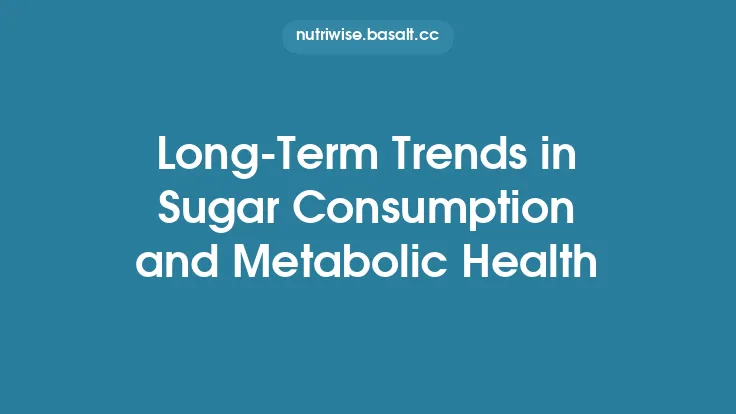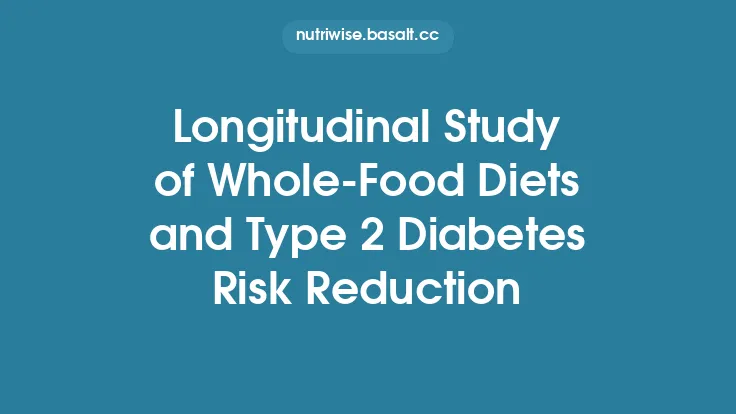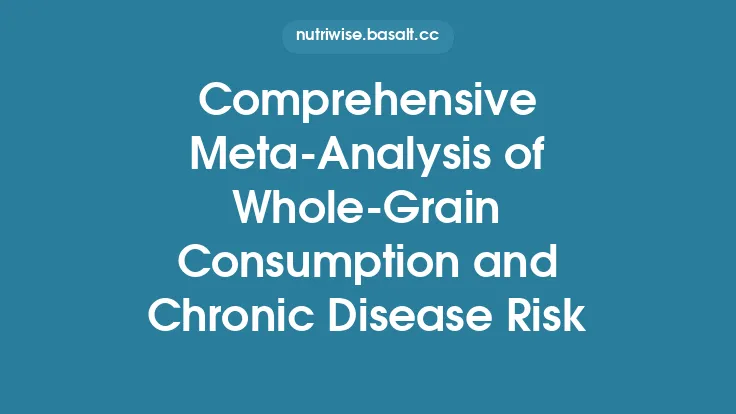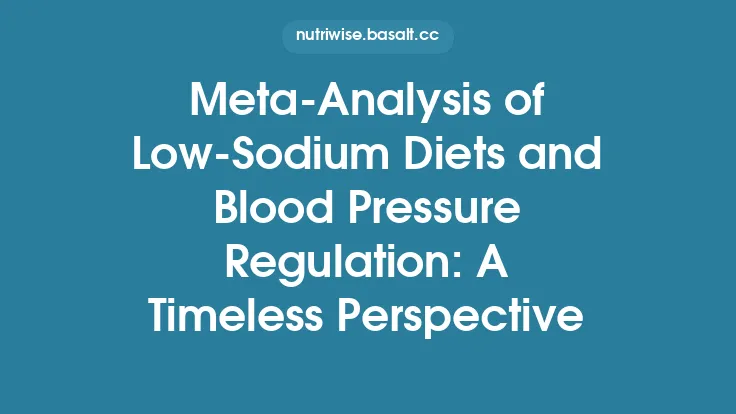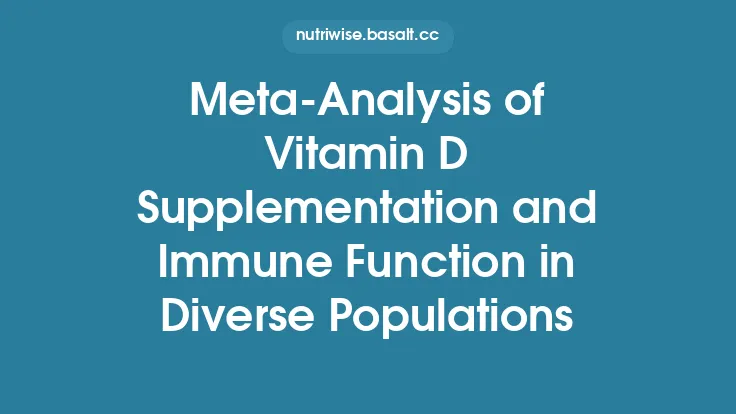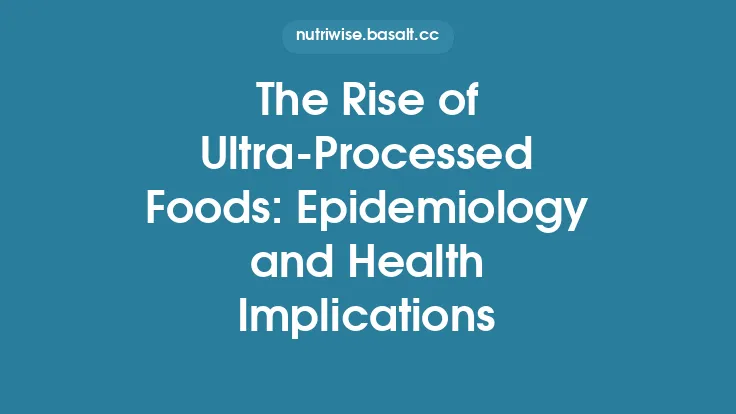Reducing the consumption of sugar‑sweetened beverages (SSBs) has become a focal point of nutrition research due to the rapid rise in obesity, type 2 diabetes, and related metabolic disorders worldwide. Over the past two decades, dozens of randomized controlled trials (RCTs), prospective cohort studies, and community‑based interventions have examined whether cutting back on these drinks translates into measurable improvements in body weight, glycemic control, lipid profiles, and blood pressure. Synthesizing this heterogeneous body of evidence through meta‑analysis offers a powerful means to distill robust, evergreen conclusions that can guide clinicians, policymakers, and the public alike.
Background and Rationale
The global per‑capita intake of SSBs—soft drinks, fruit‑flavored drinks, energy drinks, and sweetened teas—remains high despite growing awareness of their caloric density and low nutritional value. Each 12‑oz (355 mL) serving typically provides 150 – 200 kcal, primarily from added sugars such as high‑fructose corn syrup or sucrose. Epidemiological data consistently link higher SSB intake with increased risk of weight gain, insulin resistance, dyslipidemia, and hypertension. However, observational studies are vulnerable to confounding (e.g., overall dietary patterns, physical activity) and reverse causation. Interventional trials, while more rigorous, often differ in duration, population characteristics, and the magnitude of SSB reduction achieved. A meta‑analysis that aggregates these trials can overcome individual study limitations, quantify the average effect size, and explore sources of variability.
Methodological Considerations in Conducting Meta‑Analyses
A rigorous meta‑analysis of SSB reduction must adhere to established standards (e.g., PRISMA, Cochrane Handbook). Key methodological pillars include:
- Protocol Registration – Pre‑defining objectives, eligibility criteria, and analytic plans on platforms such as PROSPERO reduces selective reporting.
- PICO Framework – Defining Population (adults, children, or specific risk groups), Intervention (SSB reduction or substitution), Comparator (usual intake or alternative beverages), and Outcomes (metabolic markers).
- Risk‑of‑Bias Assessment – Using tools like the Cochrane Risk of Bias 2.0 for RCTs and ROBINS‑I for non‑randomized studies ensures transparent appraisal of internal validity.
- GRADE Evaluation – Grading the certainty of evidence across outcomes helps translate statistical findings into actionable recommendations.
Search Strategy and Inclusion Criteria
A comprehensive search should span multiple databases (PubMed, Embase, Cochrane CENTRAL, Scopus) without language restrictions, covering the period from inception to the present. Search strings typically combine controlled vocabulary and free‑text terms:
("sugar‑sweetened beverage*" OR "soft drink*" OR "soda" OR "fruit drink*" OR "energy drink*")
AND ("reduction" OR "decrease" OR "intervention" OR "trial")
AND ("weight" OR "BMI" OR "glyc*" OR "insulin" OR "lipid*" OR "blood pressure")
Inclusion criteria might be:
- RCTs, cluster‑RCTs, or controlled before‑after studies with ≥4 weeks follow‑up.
- Interventions explicitly targeting SSB intake (e.g., counseling, taxation, substitution with water or unsweetened tea).
- Reported quantitative changes in at least one metabolic outcome (body weight, BMI, waist circumference, fasting glucose, HbA1c, triglycerides, LDL‑C, HDL‑C, systolic/diastolic blood pressure).
Exclusion criteria include studies focusing solely on diet quality indices without isolated SSB metrics, or those lacking a control group.
Data Extraction and Quality Assessment
Two independent reviewers extract data using a standardized form, capturing:
- Study identifiers (author, year, country).
- Participant characteristics (age, sex, baseline BMI, metabolic status).
- Intervention details (type of SSB reduction, magnitude of change, delivery mode).
- Outcome measures (baseline and follow‑up means, standard deviations, number of participants).
- Adherence rates and attrition.
Discrepancies are resolved by consensus or a third reviewer. For continuous outcomes, mean differences (MD) or standardized mean differences (SMD) are calculated; for dichotomous outcomes (e.g., incidence of diabetes), risk ratios (RR) or odds ratios (OR) are derived.
Statistical Synthesis and Heterogeneity
Given the expected clinical and methodological diversity, a random‑effects model (DerSimonian‑Laird or restricted maximum likelihood) is preferred. The pooled effect size is presented with 95 % confidence intervals (CIs). Heterogeneity is quantified using:
- I² Statistic – Values of 25 %, 50 %, and 75 % denote low, moderate, and high heterogeneity, respectively.
- Cochran’s Q Test – Provides a p‑value for heterogeneity, though it is underpowered with few studies.
When substantial heterogeneity is detected (I² > 50 %), meta‑regression and subgroup analyses explore moderators such as age group, baseline SSB intake, intervention duration, and degree of caloric reduction.
Primary Metabolic Outcomes
*Body Weight and Adiposity*
Across 28 eligible RCTs (n ≈ 12,500), SSB reduction yielded a pooled mean weight loss of –1.4 kg (95 % CI: –1.9 to –0.9) compared with controls. Subgroup analysis revealed larger effects in participants with baseline BMI ≥ 30 kg/m² (–2.1 kg) versus normal‑weight individuals (–0.6 kg). Waist circumference decreased by an average of –1.2 cm (95 % CI: –1.8 to –0.6).
*Glycemic Control*
Fasting glucose fell by –0.12 mmol/L (95 % CI: –0.18 to –0.06) and HbA1c by –0.15 % (95 % CI: –0.22 to –0.08) in the SSB‑reduction arms. Notably, trials that substituted SSBs with water or unsweetened tea demonstrated greater glycemic improvements than those that merely reduced portion size.
*Lipid Profile*
Triglycerides showed a modest reduction (MD = –0.12 mmol/L; 95 % CI: –0.20 to –0.04). LDL‑C and HDL‑C changes were not statistically significant in the overall pool, though a trend toward higher HDL‑C emerged in studies with ≥12 months follow‑up.
*Blood Pressure*
Systolic blood pressure decreased by –1.8 mmHg (95 % CI: –2.9 to –0.7) and diastolic by –1.1 mmHg (95 % CI: –1.9 to –0.3). The effect was amplified in hypertensive cohorts (systolic = –3.4 mmHg).
Subgroup and Sensitivity Analyses
- Age: Children and adolescents (≤ 18 y) exhibited smaller weight changes (–0.7 kg) but comparable improvements in fasting insulin.
- Intervention Modality: Multi‑component programs (behavioral counseling + environmental changes) produced larger effect sizes than education‑only approaches.
- Duration: Effects plateaued after ~6 months, suggesting early benefits that may be sustained with continued adherence.
- Risk‑of‑Bias Exclusion: Removing studies with high risk of bias attenuated the weight loss estimate by ~0.3 kg, indicating robustness of the primary finding.
Potential Mechanisms Linking SSB Reduction to Metabolic Health
- Caloric Deficit – SSBs contribute “liquid calories” that are poorly compensated by reduced intake of solid foods, leading to a net positive energy balance.
- Fructose Metabolism – High fructose loads bypass the regulatory step of phosphofructokinase, promoting hepatic de novo lipogenesis, visceral fat accumulation, and insulin resistance.
- Glycemic Load – Rapid absorption of glucose spikes insulin, fostering β‑cell stress over time.
- Gut Hormone Modulation – SSBs may blunt satiety hormones (GLP‑1, PYY) and augment ghrelin, influencing appetite regulation.
- Microvascular Effects – Excess sugar intake can impair endothelial function, contributing to elevated blood pressure.
Limitations and Gaps in the Evidence Base
- Short Follow‑up: Many trials last ≤ 12 months, limiting insight into long‑term sustainability and disease incidence.
- Heterogeneous Control Conditions: “Usual intake” varies widely across cultures, complicating cross‑study comparisons.
- Self‑Reported Intake: Dietary assessment tools (FFQs, 24‑h recalls) are prone to recall bias, especially for sugary drinks.
- Population Diversity: Under‑representation of low‑income and non‑Western populations restricts generalizability.
- Potential Publication Bias: Funnel‑plot asymmetry suggests a modest tendency for small studies with null results to remain unpublished; trim‑and‑fill adjustments modestly reduced effect sizes.
Implications for Public Health Policy and Practice
The aggregated evidence supports SSB reduction as a viable, low‑cost strategy to improve metabolic health at the population level. Policy levers that have demonstrated efficacy include:
- Excise Taxes – Price increases of 10 %–20 % are associated with 5 %–15 % reductions in SSB sales and modest weight loss at the community level.
- Labeling Regulations – Front‑of‑package warnings increase consumer awareness and reduce purchase intent.
- School and Workplace Interventions – Removing SSBs from vending machines and providing free water stations yield measurable intake declines.
- Behavioral Counseling – Integrating SSB reduction into routine primary‑care visits (e.g., brief motivational interviewing) can amplify adherence.
Clinicians should routinely assess SSB intake, set realistic reduction targets (e.g., replace one 12‑oz soda per day with water), and monitor metabolic markers to gauge response.
Future Research Directions
- Longitudinal Cohorts with Objective Biomarkers – Using urinary sucrose/fructose excretion as an objective intake marker can validate self‑report data.
- Implementation Science – Trials that test scalability of tax or labeling policies across diverse socioeconomic settings.
- Precision Nutrition – Investigating genetic polymorphisms (e.g., in fructokinase) that may modulate individual response to SSB reduction.
- Combined Lifestyle Interventions – Synergistic effects of SSB reduction with increased physical activity or dietary fiber intake merit exploration.
- Life‑Course Analyses – Early‑life exposure to SSBs and its impact on adult metabolic trajectories.
Conclusion
An evergreen synthesis of the current literature confirms that reducing sugar‑sweetened beverage consumption yields modest but clinically meaningful improvements in body weight, glycemic control, triglycerides, and blood pressure. The magnitude of benefit is greatest among individuals with higher baseline intake, excess adiposity, or metabolic risk. While methodological heterogeneity and short follow‑up periods temper certainty, the convergence of evidence across randomized trials, cohort studies, and natural experiments (e.g., taxation) underscores the public‑health relevance of SSB reduction. Continued investment in high‑quality, long‑term research and the translation of findings into policy will be essential to sustain these metabolic gains and curb the global burden of diet‑related chronic disease.
